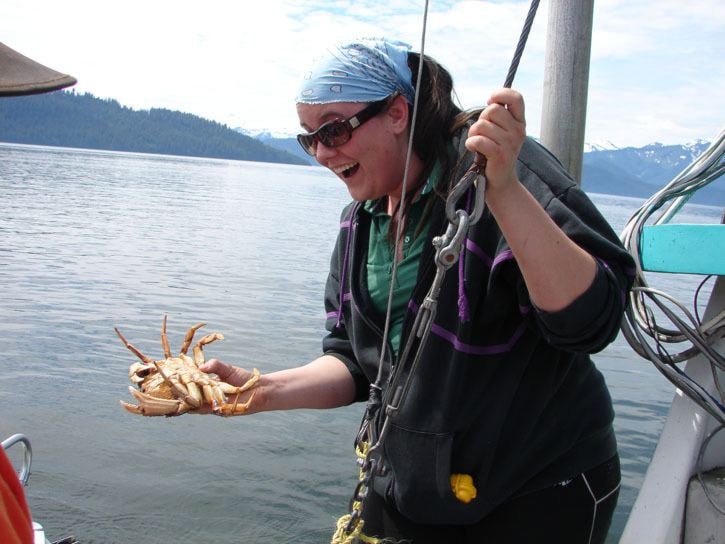On National Aboriginal Day and the summer solstice, students from Northwest Community College (NWCC) embarked on a remarkable journey to the pristine Kitlope ecosystem, and the ancestral homeland of the Haisla and Henaaksiala people. Student Courtney Berdan summed up the trip as “one great adventure, with a whole lot of little adventures within it.”
The Cultural Anthropology class, and Instructor Sheree Ronaasen, were hosted by the Nanakila Institute Society, Chair Gerald Amos, Director Nancy Nyce and Rodney Smith, on the cultural tour to the Kitlope.
The First stop along the Gardener Canal was at the old village site at Crab River. After landing on shore, students walked carefully through the giant Devils Club, to learn about the harvesting of Balsam bark, and traditional medicines. While anchored at Crab River, students also helped bring in the crab traps and, like Berdan, for some it was a first to hold on to a live crab. Later on, students experienced how to shell crabs, which Nyce transformed into beautiful crab cakes.
The first overnight stop was at Europa hot springs; surrounded by ferns, students relaxed in the thermal water, and shared their experiences from the activity-filled day. The next day, the tour proceeded up the Gardener Canal, and stopped at a special island, to learn about important plants, including rice root, silverweed, and how to harvest yellow cedar. The students proceeded along the fjord to view the steep glacier carved rock walls of the upper Gardener Canal.
After setting the prawn traps, students spent the night at Kemano. The group was fortunate to have a special tour of the Oolican camps, and learn about the processing and importance of these little fish. Over supper, students were captivated and privileged to see across the Wahoo river three huge grizzly bears river grazing on eel grass of the tidal estuary. After departing at the 5 a.m. high tide, students were excited to participate in the retrieval of the prawn traps, and to see what came out of the water. “I never knew prawns could grow so big”, said Parker McKenzie.
The cultural tour proceeded along to the end of the canal, to the estuary of the Kitlope River and the old village site of Miskusa, where the replica of the G’psgolox pole stands today. Students learned of the remarkable story of the return of the original pole from Sweden. For the complete story, refer to the NFB production Totem: Return of the G’psgolox Pole.
The last night was spent at the Kawesas Lodge. Students reminisced about their experiences on the tour, and tried to savour every last bit. Supper was superb that night, highlighting fresh prawns from the sea. “This was the best trip ever,” said Tracey McKay. “You will feast like kings.”
More NWCC student quotes about the Kitlope Field School:
Courtney Berdan: “We have sharing circles every night. It’s great hearing how everyone learned different things, and how everyone thinks about their experiences, from different points of view, even though we experienced all of the very same things together.”
Tracey McKay: “As you travel the waters, don’t forget to bring your camera, because the natural beauty of the river channels, lush green forests, estuaries, and waterfalls, will take your breath away.
Ann Peltier: “Breathtaking, put it on your bucket list.”
“I’ve lived in the community for 18 years, and did not know or understand the depth and beauty of the area. Seeing the landscapes, being on the land and water, and learning the importance of this area to the First Nations peoples, has had a profound effect on me.”
The Kitlope Field School is part of a larger special summer Field Schools and University Credit program offered by NWCC. Overall, the summer Field Schools—across the three campuses of Terrace, Prince Rupert, and Smithers—offer students the chance to learn on the land with First Nations people in the amazing geography of the Northwest. These Field Schools are unique to post-secondary education in the province and Canada.
On behalf of the class, instructor Ronaasen thanks the College and Nanakila for supporting this unique and powerful educational experience, and for building strong relationships in the community.
